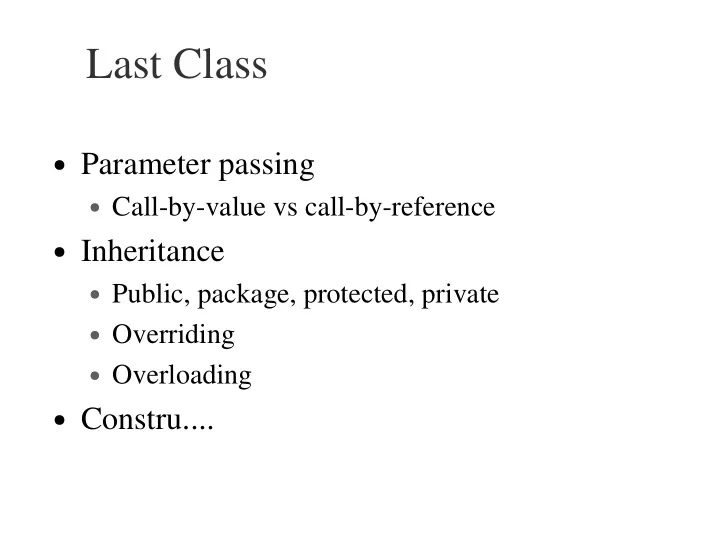

Last Class ● Parameter passing ● Call-by-value vs call-by-reference ● Inheritance ● Public, package, protected, private ● Overriding ● Overloading ● Constru....
Constructors • Every class comes with a default constructor with no parameters • Additional constructors with any number of parameters can be defined. doing so turns off the default constructor -- DANGER • If a subclass has a custom constructor A constructor of the superclass is called Then statements in the subclass’ constructor are executed • A subclass may explicitly access its super class’s constructors through the key word super
Example -- Constructors public class A public class B { { String s="???"; String s="???"; public String toString() public B(String ss) { s=ss; } { return s; } public String toString() public static void main(String[] args) { return s; } { public static void main(String[] args) A a = new A(); { System.out.println(a); B b = new B(); }} System.out.println(b); } } What is the result of A and B? Do they even compile?
More Constructors public class BB public class C extends BB { { public static void main(String[] args) { String s="???"; C c = new C(); public BB(String ss) { s=ss; } } public String toString() } { return s; } public static void main(String[] args) { Problem: C does not compile BB b = new BB(“q”); error message: System.out.println(b); } symbol : constructor B() } location: class B Interpretation: C is looking for no arg constructor in B Fix: 1. Put “public B() {}” in B 2. Put “public C() { super(null); } in C
The granddaddy class • In Java, a class may extend only one class (single inheritance/single parenting) • As we have seen, a class can have many children. This leads to a tree structure. • At the top of the inheritance tree is the class Object – all classes extend Object by default class A extends Object
References and casting • Reference variable of type superclass can be used to refer to a subclass, but not vice versa • If must be done, use explicit casting – similar to numeric type conversion • Can be tested using instanceof e.g. If (a instanceof B) { ... }
Casting public class Adult extends Person { public class Person { public Adult(String n) { super(n); } protected String name=""; public String toString() { protected Person bff=null; return getName() + bff.getName(); public Person(String s) { } name=s;} public static void main(String[] args) { public void setBFF(Person p) { bff = p; } Adult a1 = new Adult("john"); Adult a2 = new Adult("jack"); public String toString() { return "name="+name+" bff="+bff; } a1.setBFF(a2); public String getName() { return name; } a2.setBFF((Person) a1); public static void main(String[] args) { System.out.println(a1 instanceof Person); Person p1 = new Person("jane"); System.out.println(a2 instanceof Adult); Person p2 = new Person("joan"); System.out.println(a1); Person p3 = new Person("jean"); } p1.setBFF(p2); } p2.setBFF(p3); p3.setBFF(p1); System.out.println(p1); }}
Thinking about Algorithms Permuting a list Alg1: Swapping through list for (int k=0; k<size; k++) tgt[k]=k; for (int k=0; k<tgt.length; k++) { int pl = (int)(Math.random()*tgt.length); int t = tgt[k]; tgt[k]=tgt[pl]; tgt[pl]=t; } Good: fast Bad: randomness??? How do you test this?
More Algorithm Thoughts What went wrong? Maybe it had something to do with using “k” as one of the things swapped?? If yes, then replace k with a random for (int k=0; k<size; k++) tgt[k]=k; for (int k=0; k<tgt.length; k++) { int p1 = (int)(Math.random()*tgt.length); int p2 = (int)(Math.random()*tgt.length); int t = tgt[p2]; tgt[p2]=tgt[p1]; tgt[p1]=t; } Good: fixes problem with randomness?? Bad: slower
Yet more thoughts maybe swapping was a bad idea? 1. Create a list of numbers (1-52) 2. for k from 1 to 52 select a number from the list from step 1 call it the kth item in new list remove selected number from list of step 1 Good: maybe gives nice randomness Bad: array implementation of remove step may be very slow
Making classes ● Goal ● Take the deck of cards from the lab and make it object oriented ● Steps ● Decide of a preliminary set of objects ● Within each object ● Decide what data the object contains ● Decide how other objects can interact with instances of instances of the object ● i.e., what is public? ● This is often referred to as the API or “Application Programming Interface”
Recommend
More recommend